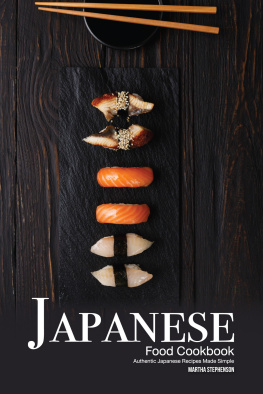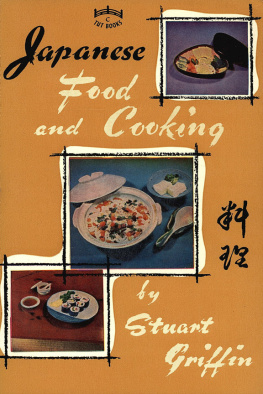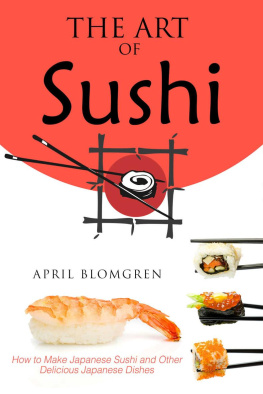The Little Japanese Cookbook explores the traditions of Japanese food, a cuisine noted for the simplicity and harmony of its flavours and the beauty of its presentation from the food itself to the dishes in which it is served.
This book includes more than 80 recipes, including street food, seafood specialities, and festival foods, as well as special features on food traditions such as sushi, tea and noodles.
C ontents

H istory, culture, religion, geography and climate have shaped J apanese cuisine into one like no other in the world.

Japanese cuisine has developed over many centuries as part of a splendid and complex civilization, initially influenced by continental Asia, but refined in its own unique way.
A round the foundation of rice, a wealth of dishes are created utilising the freshest of ingredients. Vegetables and produce from the sea predominate, while meat appears far less often and only in small quantities. Foods are prepared with a light hand, and their natural flavours and textures are emphasised. Sometimes ingredients remain raw, transformed only by stylish slicing and presentation. The cooking techniques of simmering, steaming, grilling, deep-frying and pickling are all quite simple, yet in Japanese cuisine they are handled with a special touch. Flavours are typically delicate, rarely obvious, and never overpowering; instead they play on complementary tastes and subtle combinations. Many foods are eaten at room temperature, which is believed to further enhance flavour. The taste of soy sauce is commonly present, also a slight sweetness born of the syrupy rice spirit, mirin.
Even shapes are said to have a taste, for Japanese cuisine considers the eyes as well as the palate to be important. Ingredients are cut into pieces not only does this make them easy to manage with chopsticks, but the variety of interesting shapes also provides visual appeal. The typical Western presentation of large portions of several foods all heaped on the same plate, the sauce from one running into the others, seems unappealing, even abhorrent, to the Japanese, who are accustomed to small portions, each in its own serving dish, with its own particular flavour or melange of flavours.
Because the serving dish is chosen to enhance the food within, rather than simply contain it, this varied cuisine calls for a rather large and eclectic assortment of small plates and bowls, in different shapes, colours, patterns and materials. Skilled artisans have been meeting this demand for centuries by producing pottery, porcelain, lacquerware and basketry of astonishing beauty. Even inexpensive, everyday, factory-produced tablewares are frequently handsomely styled as well.
The seasons have a strong influence on the ingredients chosen, dishes prepared and serving utensils used. The garnish chosen to complete the artful arrangement of food on the plate also reflects the time of year, with perhaps cherry blossoms in spring, a dewy sprig of bamboo in the heat of summer, red maple leaves in autumn, or pine needles in winter. It is truly a singular experience to behold the way all of these elements come together on a table beautifully arranged with a kaiseki banquet, the pinnacle of Japanese cuisine.
In Japan, noodles are nearly as popular as rice, and that is really saying something. Every village seems to have at least one noodle bar, towns can have dozens of them, while Tokyo alone has thousands. At their most basic, noodles are sold from yatai mise. Once very common, these wheeled carts still set up in the early evening on corners all over the business districts. They sell simple, hot, filling and cheap noodle snacks to fortify hungry salarymen for a night out on the town or to stave off hunger until they eat dinner at home. More established noodle shops can be found in or near almost every train station, in department stores and food arcades, and along any street. Some are basic tachigui bars where patrons stand while they eat, others have stools or booths but remain quite utilitarian, while still others are decked out in a rustic style of dark wood, indigo textiles and pottery. The best of these noodle shops make their own noodles, the master skilfully mixing, kneading, rolling and cutting in the front window, tempting customers to duck under the noren curtain for a real treat. Fine noodles deserve a fine broth, and house recipes are closely guarded secrets.
An izakaya (also called aka chochin after the red lantern that typically hangs at the entrance) is a place to sit back and enjoy drinking sake in a convivial atmosphere. It is a place where patrons can pause between work and home. Izakaya range in styles to suit taste and budget. At their simplest they are the hole-in-the-wall bars with no more than a half-dozen stools and a mama-san tending to her regulars with a house sake and a few home-cooked tidbits. Then there are larger, more stylish establishments offering dozens of quality regional sake from remote corners of the archipelago and many small, tasty dishes to accompany it. The best invariably offer a homey and intimate atmosphere, and the owner takes pride in knowing the regular customers, remembering their favourite brand of sake , and recommending others to suit their taste. The dim and smoky atmosphere (smoke from cigarettes as well as from the grill) of izakaya has traditionally been restricted to men. But today they are also frequented by couples and working women, and many now cater to the growing number of female customers by providing comfortable surroundings to suit them.

Tokyos vast central wholesale market at Tsukiji is a world of its own. Nearly 3,000 tonnes of fish pass through it each market day, which works out at some 900,000 tonnes per year. The day starts early, as workers bow at the entrance of Namiyoke Jinja, the Wave-calming Shrine, by the market gate. Fishing boats dock at the pier and trucks roll in through the dark hours, delivering the fresh seafood catch from Japans fishing ports, as well as air cargo from around the world. The largest and most celebrated of the markets products, frozen tunas, are inspected and readied for the days auction. Near dawn, auctioneers and bidders begin their frenzied rounds of shouting and hand signals, completely unintelligible to the uninitiated, closing a sale every few seconds. Restaurateurs, middlemen and retailers make their daily selection from the hundreds of stalls that together offer more than 400 varieties of seafood. A good mornings work behind them, by 8 oclock buyers and sellers are ready for breakfast at one of the market restaurantsthe freshest sushi on earth.























